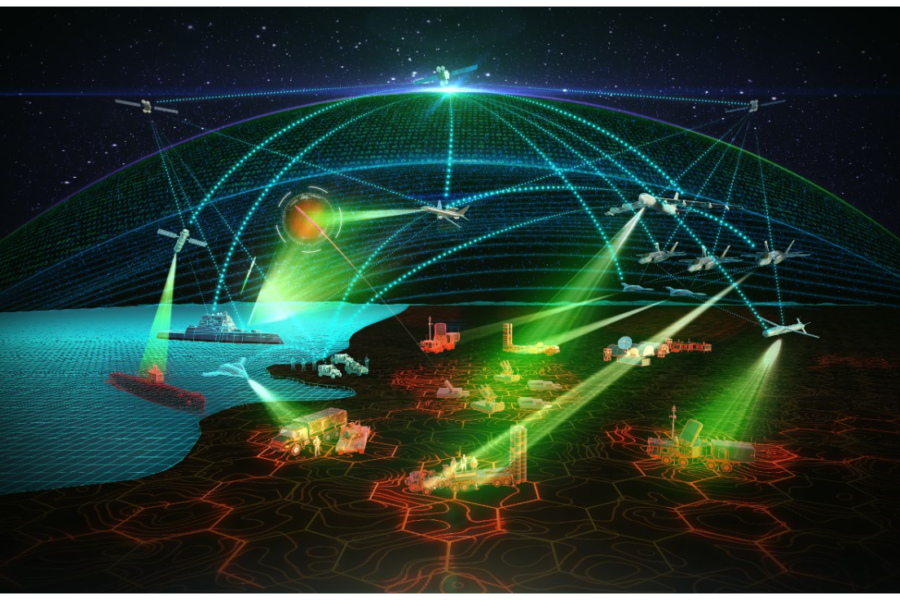The Department of Defense recently declared it now has a “North Star,” with Secretary of Defense Lloyd J. Austin III’s signing of the joint all-domain command and control (JADC2) strategy.
To be clear, JADC2 is not a singular program but instead a strategy designed to accelerate decision-making in an increasingly complex threat environment. The big idea is that if our military commanders can decide faster, then our armed forces can act faster, giving them a clear advantage over the adversaries of our country and its allies.
Industry will play a critical role in developing the underlying systems and architectures needed to make JADC2 a reality. While dozens of capabilities will ultimately contribute to the success of JADC2, three stand to shape its very foundation—artificial intelligence, resilient communications, and universal translation.
The joint force will depend on automated networks and AI to efficiently cull through petabytes of data. The Pentagon’s recent launch of the Artificial Intelligence and Data Acceleration Initiative underscores the Defense Department’s focus to prepare military commanders and operators for this new data-driven threat landscape. Applying these technological advances will help operators manage, analyze, and act on unprecedented volumes of data.
Raytheon Intelligence & Space is integrating predictive algorithms and AI into technologies, such as our proposed system for the U.S. Army, Tactical Intelligence Targeting Access Node, or TITAN, to optimize use of the overwhelming amount of data sources available. The integrated system can autonomously sift through massive amounts of sensor data with the help of AI to rapidly find and track potential threats, offering increased speed and precision to mission operators on the ground.
As our allied forces pivot toward future contested security environments, one thing is certain—peer threats have the capability to strike and hamper access to information in every domain. The future battlespace will need to account for limited and severed access to systems and resources. As a result, it is imperative that the JADC2 framework not devolve into a single point of failure. Rather, industry must strive to provide solutions that operate sufficiently across resilient open architectures and in degraded conditions to sustain joint force and allied operations. Core to bringing JADC2 to fruition is embracing the concept of degradation dominance as a Center for New American Security Information and Command study notes.
Recognizing that the multi-domain battlespace will have disrupted connectivity, secure communications must be self-healing to ensure data is delivered in those crucial moments. And secure communications will play a significant role in preserving JADC2’s data integrity and trustworthiness due to the amount of data available.
Resilient communications across all domains, especially in space, will be key to mission success. Safeguarding the delivery and management of data in space will fill the existing operational gap of accelerating data sharing in tactical conflicts. It will also expand the joint force’s orchestration of assets to conduct automated tasking from space.
To succeed in this potentially fragmented environment, our technology community can provide creative applications for a universal translator to connect the future joint force. JADC2 will hinge on rapidly sharing data across the services’ existing and future systems in every domain. The integration of a translation gateway must be factored in to accelerate the sharing of data and aid military commanders in making better command decisions.
Given the challenge ahead to stand up a fully interoperable joint force with coalition partners, a “Rosetta Stone” network will help fill an operational gap to pass data between systems and across all of the services as the CNAS study reports. There will be different communications requirements in every domain, including new data translation capabilities. For example, solutions such as DARPA’s Dynamic Network Adaptation for Mission Optimization program can provide the channel to share data seamlessly in future contested environments. Advanced networking technologies like DyNAMO will be essential to developing a JADC2 architecture that effectively serves our forces in peer-to-peer conflicts.
As domains converge in the modern connected battlespace, industry has a critical role to provide pragmatic and effective solutions to turn JADC2 into a reality. The approval of the Defense Department’s JADC2 strategy marks an inflection point, and the next steps of its implementation will be consequential as Lt. Gen. Dennis A. Crall, CIO/J6 of the Joint Chiefs of Staff, at a recent Department of Defense news conference said, “It’s now implementation time. Planning is good. Talk is good. Now it’s delivery time, and we’ve been given a clear signal to begin pushing these outcomes to the people who need them.”
The urgency and the strategy are clear. The innovators of industry and government must evolve our thinking and approach to develop a JADC2 architecture that serves the joint force well in contested conditions by accounting for AI-driven solutions, degradation dominance, and universal translation pathways. Incorporating these design assumptions will help ensure we have a strengthened joint and allied defense for true multi-domain operations.
Author’s Note: John Dolan is the vice president of Air and Space Dominance at Raytheon Intelligence & Space. He is a retired Air Force lieutenant general who last served as director of operations on the Joint Staff from 2016 to 2018.
